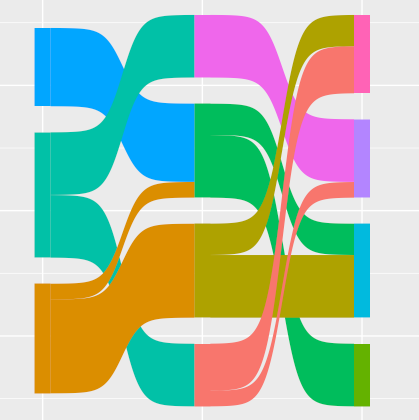This visualization shows how different renewable energy sources have
contributed to global electricity generation from 2000 to 2023. The
geom_sankey_bump() function creates flowing streams
that expand or contract to show changes in generation capacity, with
technologies shifting positions when their relative contribution
changes over time.
library(tidyverse)
library(ggsankey)
# Read and prepare the data
renewable_data <- read.csv("https://ourworldindata.org/grapher/modern-renewable-prod.csv?v=1&csvType=filtered&useColumnShortNames=true") %>%
# Select last 10 years for better visualization
filter(Year >= 2000) %>%
pivot_longer(
cols = c(wind_generation__twh, hydro_generation__twh,
solar_generation__twh, other_renewables_including_bioenergy_generation__twh),
names_to = "technology",
values_to = "generation"
) %>%
mutate(
technology = case_when(
technology == "wind_generation__twh" ~ "Wind",
technology == "hydro_generation__twh" ~ "Hydro",
technology == "solar_generation__twh" ~ "Solar",
technology == "other_renewables_including_bioenergy_generation__twh" ~ "Other Renewables"
)
)
# Create the plot
ggplot(renewable_data,
aes(x = Year,
node = technology,
fill = technology,
value = generation)) +
geom_sankey_bump(space = 0,
type = "alluvial",
color = "transparent",
smooth = 6) +
scale_fill_viridis_d(option = "inferno", alpha = .8) +
scale_x_continuous(breaks = scales::pretty_breaks(), expand = c(0,0)) +
scale_y_continuous(labels = scales::comma, expand = c(0,0)) +
theme_sankey_bump(base_size = 16) +
labs(x = NULL,
y = "Electricity Generation (TWh)",
fill = "Technology",
title = "Global Renewable Energy Generation by Source",
subtitle = "Period: 2000-2023",
caption = "Data sources: Ember (2024), Energy Institute - Statistical Review of World Energy (2024)\nProcessed by Our World in Data") +
theme(legend.position = "bottom",
legend.title = element_text(hjust = 0.5),
legend.title.position = "top",
plot.caption = element_text(hjust = 0, size = 10, face = "italic"))





